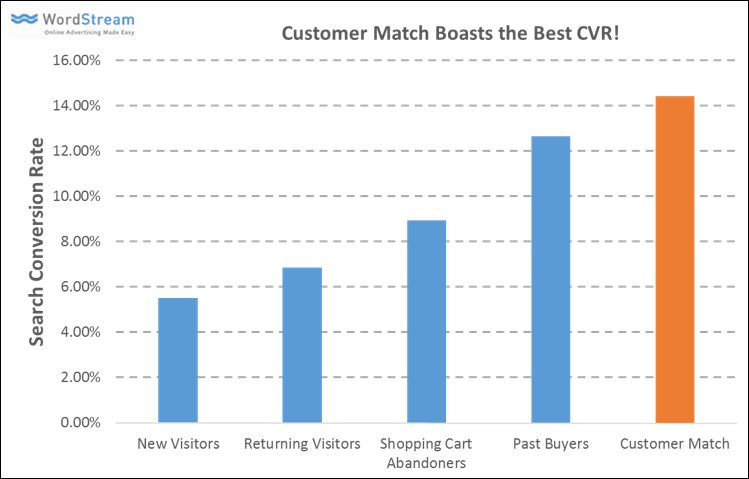
Customer Match is not a new feature by any means. In fact, it’s been around for over 3 years. When Google first introduced Customer Match in 2015, it allowed search advertisers to create and target custom audiences based on a list of user email addresses in their Search, Gmail, and YouTube campaigns within AdWords.
What is a relatively new option, is the fact that Customer Match now also allows advertisers to match customers by the phone number and their mailing address. In other words, with the new features, advertisers can now create a customer match audience that includes any combination of email addresses, physical addresses, and phone numbers and upload them into Google Ads to target in their Search, Shopping, Gmail, and YouTube campaigns. Google Display Network matching is not available at this point.
But first, for those of you new to the concept, let’s let Google explain what is Customer Match.
About Customer Match (from Google)
Customer Match lets you use your online and offline data to reach and re-engage with your customers across Search, Shopping, Gmail, and YouTube. Using information that your customers have shared with you, Customer Match will target ads to those customers and other customers like them.
Customer Match is a useful advertising tool for many business goals, from increasing brand awareness to driving conversions. Here are a few examples of different audiences you can target with Customer Match:
- On the Search Network and Google Shopping, you can optimize your campaigns by adjusting your bid based on what you know about your customers’ activities.
- On Gmail, you can reach your customers or similar audiences using personalized ads at the top of their inbox tabs.
- On YouTube, you can reach new audiences, by targeting audiences similar to your most valuable customers.
Traditionally, you would upload your email database to Google and perhaps about 40% to 50% of those leads would be successfully matched by Google. That rate in itself is a great result. However, now you can also add parameters such us mailing addresses (from previous Direct Mail campaigns) or phone numbers (from other databases or even SMS campaigns) the chances of Google being able to match your audience increase exponentially. Basically, the more data you can provide on your users, the higher the likelihood that Google will be able to match your data to its users.
The matching ability is so great, that according to WordStream, Customer Match provides the higher search conversion rate from all other types of audiences.

If you’re concerned about how this type of targeting option will interfere with customers’ privacy, so is Google. As a company that lives off their customers loyalty and positive experience while using the Search Engine, Google’s implementation of Customer Match has a few rules of engagement added to it. For example, Google indicates that advertisers can only upload customer information that they’ve obtained in the “first party context.” Examples of first party data include emails collected through website forms, apps, online purchases that clearly allow customers to indicate their desire to receive information, physical stores and in-person events; basically, any type of “opt in” situation where the customer has expressed interest in your business and he or she is willing to receive more information in the future. Google also recommends that advertisers note that they may collect emails for remarketing purposes on their website’s Privacy Policy page.
One additional note about email addresses. Contrary to what most marketers seem to think, your customers email addresses do not have to be Gmail-only. Google’s Customer Match will also attempt to match any non-Gmail addresses to specific users and based on our experience, the results have been excellent. The one caveat that may affect some advertisers is that Google also requires a minimum of 1,000 matched email addresses to enable Customer Match. So for example, if you upload 2,000 email addresses and the match rate is around 50%, you should end up with around 1,000 valid email addresses that will allow you to enable Customer Match for your specific campaign.
Conclusion
Since few small businesses have the capacity for such time-intensive and complex work, MGR’s Digital Marketing Team takes care of all the correct audience targeting and research for you resulting in placing the right ads in front of those customers with the higher probability of converting at the lowest possible bid.
Our “Intelligent Match” program provides higher conversion rates without wasting ad spend on ‘tire kickers’ with low or no intention of purchasing at any particular time. And this is just the beginning. Our Market Intelligence project is loaded with experimental techniques to intercept buyers and leads before they are lured by other marketing giants… and it keeps progressing week after week. Just like a platoon of 16 Navy SEALs can destroy an entire enemy infrastructure with highly targeted missions, you can apply similar marketing techniques to beat larger marketing establishments before the take your customers away from you.
Photo by Heidi Sandstrom. on Unsplash
Sources: WordStream, Google Ads,




